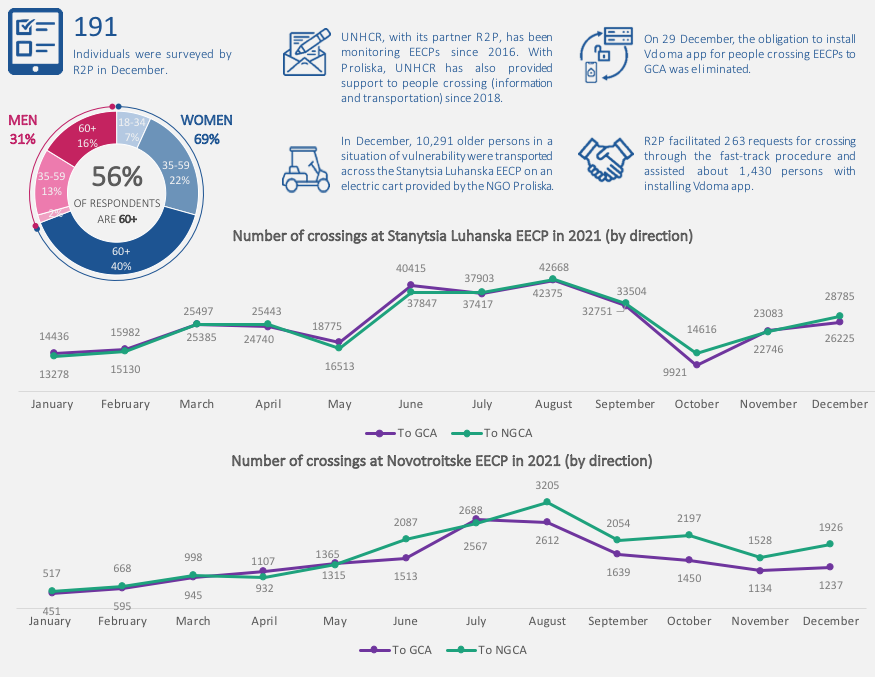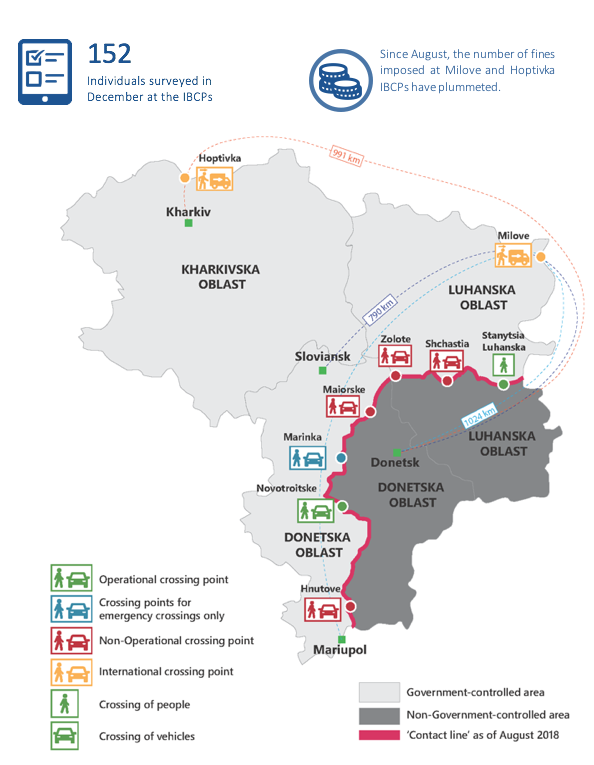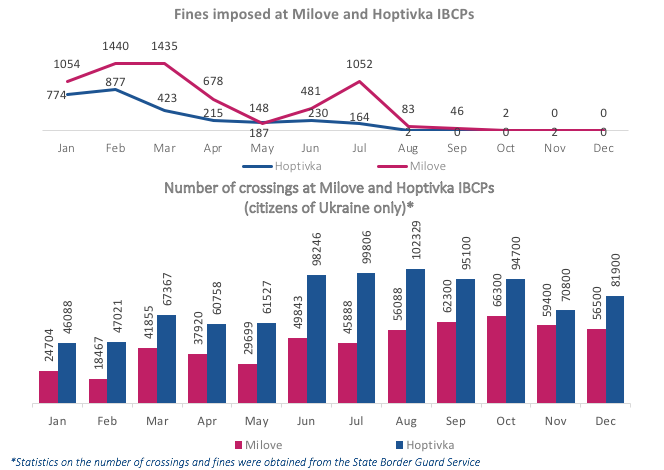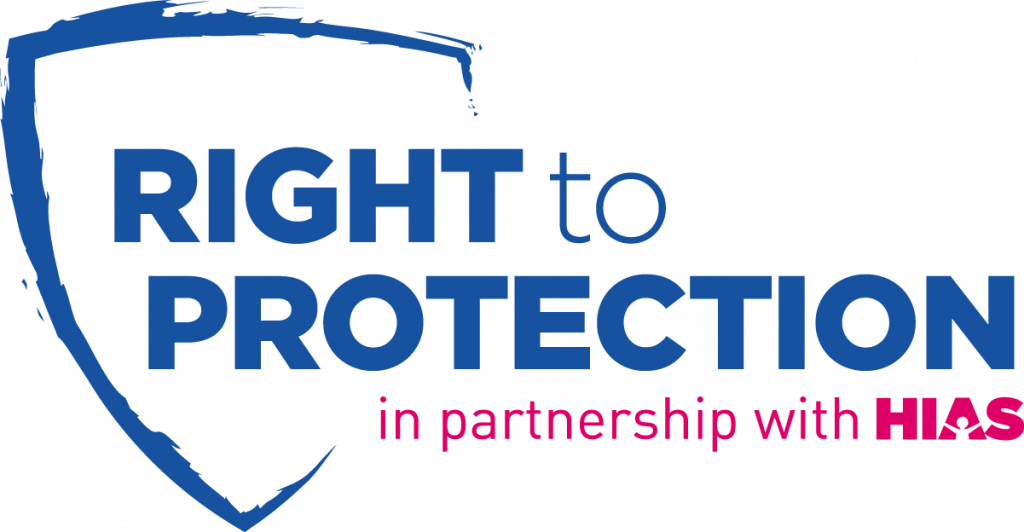-
Unfortunately, nothing was found for your request, you can search for another keyword, or contact us with your question through the feedback form
Search results (25)
All results (25)
REPORT: "Survey on the conditions of crossing the EECPs and IBCPs in eastern Ukraine". December 2021
January 17, 2022
Today we present the December 2021 report on the conditions for crossing the Entry-Exit Checkpoints (EECPs) and International/Interstate Border Crossing Points (IBCPs). The report is based on the data collected during the monitoring of the situation at the EECPs in Donetsk and Luhansk oblasts (eastern Ukraine), as well as on the IBCPs “Milove” and “Hoptivka” on the border with Russia.
The purpose of the survey is to gather information on the difficulties and problems faced by the citizens, who are traveling across the Non-Government Controlled Areas (NGCA) and Government-Controlled Areas through EECPs on the contact line in eastern Ukraine, and IBCPs on the border with Russia.
More statistical data is available on the Online Dashboard.
CROSSING THE CONTACT LINE:
December 2021 EECP Survey Snapshot
- In 2021, only two of seven Entry-Exit Checkpoints (EECPs) were open on both sides on the contact line: Novotroitske, in Donetsk Oblast, two days a week and Stanytsia Luhanska, in Luhansk Oblast, seven days a week. The number of crossings in 2021 was at a level considerably below the pre-COVID period. In December 2021, the number of crossings at Novotroitske EECP was 3,163, which is only 1,3 per cent of that in December 2019. The same can be deduced from the number of crossings at Stanytsia Luhanska EECP where the number was 55,010 in December 2021, which is 16,7 per cent of that in December 2019. COVID-19 preventative measures are cited by the de facto authorities as their reason to keep the other EECPs closed.

- On 29 December, the Cabinet of Ministers of Ukraine eliminated the requirement to install the Vdoma location-aware app and self-isolation for people crossing EECPs to GCA. This also means that isolation in a state-run observation facility is no longer obligatory as it was for people who could not install the Vdoma app. However, restrictions on crossing EECPs on the NGCA side are still being applied.
- Infrastructure rehabilitation works began at Novotroitske EECP: a new module to support pedestrian crossings is already operational and another should arrive soon. Recently, infrastructure improvements at Stanytsia Luhanska EECP were completed, including the installation of new modules and delivery of required equipment, and baggage scanners. In addition, a new administrative service centre will be built at Marinka EECP.
- Since November, people who want to cross the contact line have been unable to register at the Security Service of Ukraine (SSU) website. Only already existing accounts are able to make submissions. This problematic situation for people crossing the contact line reinforces the urgency of the request R2P sent on 30 December 2021 to the CMU to amend order № 815 by revoking the requirement to obtain a permit to cross the contact line as excessively restrictive and hence unconstitutional.

GOING AROUND THE CONTACT LINE:
December 2021 IBCP Survey Snapshot
- In December, most respondents at Milove and Hoptivka IBCPs were residents of Donetsk NGCA (48%) compared to the number of residents of Luhansk NGCA (24%). The remaining 28% were residents of Donetsk and Luhansk GCA and other Ukraine oblasts. According to SBGS statistics, the number of crossings at Milove IBCP in 2021 doubled compared to 2020, whilst at Hoptivka IBCP the situation remained the same. Thus, the number of crossings at Milove IBCP was 277,000 in 2020, against 548,964 in 2021. At Hoptivka IBCP, 960,880 crossings were recorded in 2020, against 925,705 in 2021.
- Installation of the Vdoma app is no longer required for people crossing through EECPs, however, it still remains a requirement for those crossing through IBCPs. The lack of free COVID-19 tests at both IBCPs makes the process of crossing more complicated. Thus, in December, at Milove IBCP, 39 people were sent for observation. Most were older persons, who could neither install the Vdoma app nor afford COVID-19 tests.

- On 21 December, UNHCR successfully finalized rehabilitation works at Milove IBCP to enhance the safety and dignity of crossing and reception conditions. The project was launched thanks to cooperation between UNHCR Ukraine and the Luhansk Region Civil Military Administration. The project will improve the reception conditions at Milove IBCP to enhance the safety and dignity of the people crossing.

The report is available in:
ENGLISH
and
UKRAINIAN
The report is based on the results of a survey, regularly conducted by the specialists of the Charitable Fund “Right to Protection” (R2P) since June 2017 at Entry-Exit Checkpoints in the Donetsk (Mayorske, Marinka, Hnutove and Novotroitske) and Luhansk (Stanytsia Luhanska) oblasts. Since August 2021 the survey is also conducted at the "Milove" IBCP (Luhansk oblast) and the "Hoptivka" IBCP (Kharkiv oblast).
The survey is part of the monitoring of violations of the rights of the population affected by the conflict and is conducted within the project "Advocacy, Protection and Legal Assistance to the Internally Displaced Population" implemented by the R2P with the support of the United Nations High Commissioner for Refugees (UNHCR). The purpose of a survey is to explore the reasons and concerns of those traveling from the NGCA to the GCA, as well as conditions and risks associated with crossing the ‘contact line’ and state border through EECPs and IBCPs. The information collected in the survey helps identify protection needs, gaps, and trends, and provides an evidentiary basis for the advocacy efforts.
ALSO READ:
